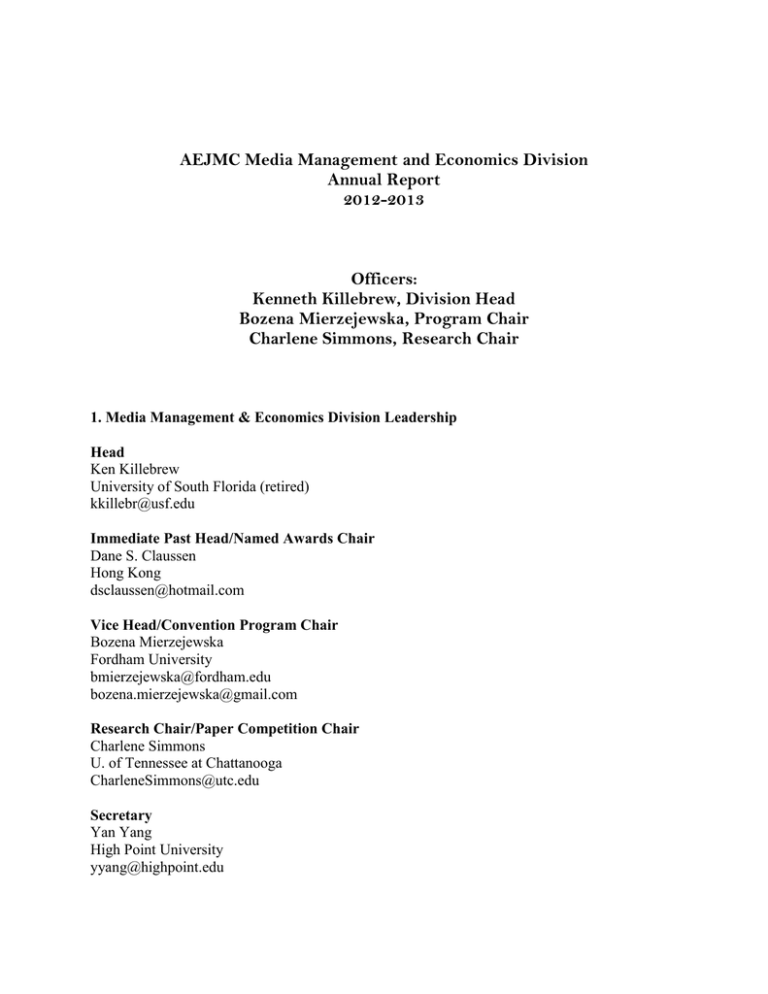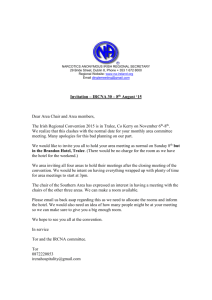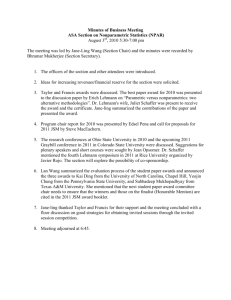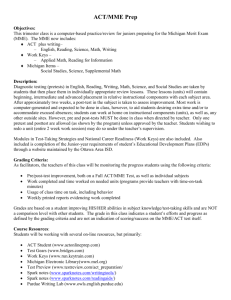MME Annual Report 2012-13
advertisement

AEJMC Media Management and Economics Division Annual Report 2012-2013 Officers: Kenneth Killebrew, Division Head Bozena Mierzejewska, Program Chair Charlene Simmons, Research Chair 1. Media Management & Economics Division Leadership Head Ken Killebrew University of South Florida (retired) kkillebr@usf.edu Immediate Past Head/Named Awards Chair Dane S. Claussen Hong Kong dsclaussen@hotmail.com Vice Head/Convention Program Chair Bozena Mierzejewska Fordham University bmierzejewska@fordham.edu bozena.mierzejewska@gmail.com Research Chair/Paper Competition Chair Charlene Simmons U. of Tennessee at Chattanooga CharleneSimmons@utc.edu Secretary Yan Yang High Point University yyang@highpoint.edu Blog/Newsletter Editor Jim Eggensperger Iona College jimegg@optonline.net PF&R Committee Chair Amber Hinsley St. Louis University ahinsley@slu.edu Webmaster/Listserv Manager (until July 2013) Michel Dupagne University of Miami (FL) duagnem@miami.edu International Service/Outreach Chairs Karin Puehringer, U. of Zurich k.puhringer@yahoo.de; Kenneth C.C. Yang, U. of Texas at El Paso Membership Chair Kris Boyle Creighton University KrisBoyle@creighton.edu Graduate Student Liaison Magda Konieczna University of Wisconsin, Madison konieczna@wisc.edu Board Members at Large Nikhil Moro University of North Texas nmoro@unt.edu Mike Wirth Tennessee mwirth@utk.edu Fred Schiff University of Houston fschiff@uh.edu Krishna Jayakar Pennsylvania State Kpj1@psu.edu 2. Annual Demo Form: See attached 3. Media Management and Economics division Activities The centennial convention in Chicago provided the Media Management and Economics division opportunities for creating an environment that would boost membership and help the division raise its awareness among AEJMC members nationally and internationally. The concepts taken forward for the 2012-2013 year and the 2013 convention in Washington D.C. included placing an emphasis on seeking new members from AEJMC’s growing international membership. Our focus then for 2013 was to grow membership at the international level while continuing emphasis on seeking out newly minted doctorates and doctoral students to improve and enhance the group’s diversity and voice. We continue to work towards increasing our diversity and the number of panels with international voices was significant, in part because of Program Chair Bozena Mierzejewska’ s strong international presence and background. The Program Chair also instituted a sponsored social session that was well attended by both members and those interested in becoming members. Numerous PF&R panelists were present at the social, bringing the number of participants to about 80-90 people, many who were not active division members. The off-site visit to the Federal Communications Commission was an outstanding success for the division. Because the 2013 convention was held in Washington D.C. the division’s leadership decided that we could take advantage of the strong PF&R opportunities in the nation’s capitol. Both Research and PF&R goals were met with a strong emphasis on PF&R invited research panels. We held six invited and cosponsored panels, three on PF&R, two on invited research and one on Teaching. During AEJMC’s final chip session in Dallas, division head Ken Killebrew and Program Chair Bozena Mierzejewska reached out to several divisions to co-sponsor these sessions. Turnout was very good at all of them. Teaching had been an emphasis two years ago in Denver and the long view expects that the balance across the board on Research, Teaching and PF&R will be met. An emphasis on Teaching will be needed in either 2014 or 2015 to ensure the balance is maintained. The division is due for review in 2015. For the first time, the MME Division awarded its PF&R award for Outstanding Professional Freedom and Responsibility in the professional ranks of media managers and journalists. The award was given to two individuals who have been on the frontline of fighting to keep the profession strong and viable. In 2012, the division did not award either of its ongoing traditional awards: the Barry Sherman Teaching Award and the Robert Picard Book award (an award recognizing outstanding scholarly writing in either a monograph or book). In 2013, the Picard award was given, but the Sherman award remained dormant. It is not considered to be an annual award, but the division does need to increase awareness about this award for the coming year since members may self-nominate. Refereed Research sessions for the 2013 convention included participants in the Scholar-to-Scholar session and two research sessions. There was an emphasis on the High Density and the Scholar-to-Scholar sessions this year per expectations of the COD. The High Density session posted nine participants while six papers were presented in the Scholar to Scholar session. The refereed research session had five participants. In an unusual predicament, ten papers were disqualified for revealing personal data. This means that of the 39 submissions, 29 were reviewed and 16 were accepted. We hope that the clarity in posting papers for review is better for the 2013-2014 session as this is a deep concern for the leadership that nearly a quarter of the papers submitted were rejected before review. The actual number of papers submitted was similar to that of the past two years (43 and 47 respectively). 4. Goals Met and Unmet-MME Division During the 2012-2013 year, we were able to reach out to the community of international scholars. Membership, however, has remained static. It is believed that the continuing restraints on spending in higher education may be a problem for the division. For a number of years the leadership has recognized that MME is often a second or third membership choice by AEJMC members. It is a continuing process in moving these individuals to see MME as a first choice division and a division in which they should work for and into the leadership themselves. Active MME membership at an early AEJMC membership level will provide for continued future growth in our leadership ranks. It is possible that clarity must be added to the submission process in order to reduce the number of rejected, non-reviewed papers to the refereed sessions. Losing a quarter of the submissions is not acceptable and must be addressed in the coming year. I was personally contacted by three separate individuals whose papers were not reviewed seeking clarification on what they had done incorrectly. Two of these individuals are nationally/internationally recognized scholars in our field. They remained confused about how they violated the rules even after our discussions. Our PF&R committee and chair was extremely helpful this year in getting out the important sponsored/co-sponsored PF&R sessions at the 2013 convention. For the 2013-2014 year, the incoming division head expects to move forward with continued dynamic programming for the 2014 convention. Joint sessions have worked well for the division for the past several years and will continue to be a focal point as AEJMC moves from a chip programming process to a consensus process through the central office. This may or may not prove challenging, but will provide an interesting future. An emphasis is also expected to continue in improving diversity and international outreach. This will be accomplished through publicizing the research paper competitions and the focus on panels that reflect both national and international interests. The PF&R, Teaching and Research committees were active in submitting a variety of proposals for panel sessions for the 2013 convention. We have already heard that the committees have been active for the 2014 submissions as well. It is an important part of our division’s activity to look to these individuals for submissions. 5. Number of faculty research paper submissions were 17 with nine accepted for an acceptance rate of 53%. 6. Number of student research papers submitted were 12 with seven accepted for an acceptance rate of 58%. 7. The Media Management and Economics division utilized the judging and submission process set up on the AEJMC site for All-Academic. As reported earlier, it may be necessary to review the submission process before actually opening submissions in 2013-14. 8. The total number of judges was 33 who evaluated three to four papers each. A complete list of accepted and delivered papers follows: The emergence and development of hyperlocal news websites: An organization ecology approach, Wilson Lowrey, Is Online News Still An Inferior Good? Re-Examining The Economic Nature of Online News and Print Newspapers, Mengchieh Jacie Yang, Texas State University Lost in Transition; Managing convergence at regional newspapers, Marco Van Kerkhoven, Utrecht School of Journalism, Klaus Schönbach * Diffuse Competition and the Decline in Newspaper Advertising, John Dimmick, Ohio State University Less is Better? The Impact of Reduced Newspaper Publication Schedule on Advertising Revenue, H. Iris Chyi, University of Texas at Austin, James Ian Tennant, University of Texas at Austin Do extended brands affect parent brands?: Focusing on feedback effect and expectation-disconfirmation theory, Sang-Ki Baek, Byeng-Hee Chang, Sang-Hyun Nam, When Ideology Meets Bottom Line, Seok Ho Lee, University of Texas at Austin Examining the Effect of Innovation on the Market Structure of the U.S. Media Industry, Tom Vizcarrondo * Inception of the Relationship Between Competition and Viewpoint Diversity in Media Ownership Policy, Christopher Terry, University of Wisconsin-Milwaukee Who’s Minding the Station? An Exploration of Shared Service Agreements within U.S. Local Television Markets, Kevin Hull, University of Florida, Amy Jo Coffey, University of Florida Motion Picture Firms’ Strategic Use of Product Placement: An Examination of Intrinsic and Extrinsic Cues, Jiyoung Cha, George Mason University * Social Media as Branding Tools: Exploring the Relationship between Perceived Social Media Use and Brand Relationship * Sylvia Chan-Omlsted, University of Florida, Moonnhee Cho, University of South Florida Bandwagon Effects of Popularity Information on Audience’s Media Product Selection: Information Load and Cultural Unfamiliarity, Xuexin Xu, Wei-Jen Wayne Fu, A Comparative Study: Hollywood and Korean Sequel Films’ Performance in Korea, Dam Hee Kim, University of Michigan, Ann Arbor * Windowed Distribution Strategies for Substitutive Television Content: An Audience-Centric Typology, Ronen Shay, University of Florida * Antecedents and Consequences of Social Television Viewing with Network Primetime Programming, Miao Guo, Ball State University Bounded Rationality and Consumer Choice: An Evaluation of Consumer Choice of Mobile Bundles, Miao Miao, Southwest Jiaotong University, Krishna Jayakar, Penn State University *asterisk denotes award winner 9. The MME Division did not conduct any secondary or other creative/refereed sessions. 10. The MME division co-sponsored four invited research/panels. Two with the Advertising Division, one with the Magazine Division, and a fourth with the Entertainment Studies Interest Group. Those sessions were: Reading the [Fragmented] Audience: Approaches to Audience Analysis in the New Media World (with Entertainment Studies Interest Group) Moderating/Presiding: Jason Zenor, SUNY-Oswego Panelists: John Carey, Fordham, Philip Napoli, Fordham, Carol Ames, California State-Fullerton, Chuck Lubbers, South Dakota, Lisa T. Fall, Tennessee, Discussant: John Sullivan, Muhlenberg College Media Branding 2.0: Changes, Challenges and Conceptions (with Advertising Division) Moderating/Presiding: Sabine Baumann, Jade, Germany Panelists: Media Brands in a Popular Culture: Towards an Audience-centered Approach, Kati Förster, Vienna, Austria and Sabine Baumann, Jade, Germany; Cross-media Marketing, Media Brands and Value Creation, Ulrike Rohn, Tartu, Estonia; Does Brand Personality Sell? An Investigation of Success Factors of Brand Management in the Newspaper Industry, Christoph Sommer and Isabelle Krebs, Zurich, Switzerland; Brand Equity and the Digital Media Experience, Scott Hamula, Ithaca Discussant: Kati Förster, Vienna, Austria The Business Model of the Future Newspapers: Multiplatform Ad Sales and Subscription on Devices (in Memory of Mary Alice Shaver) Moderating/Presiding: Louisa Ha, Bowling Green State University Panelists:Robert Picard, Director of Research, Reuters Institute, University of Oxford; Dena Levitz, Digital Strategies Manager, Newspaper Association of America; Dan Shaver, Elon University; David Hunke, Chief Strategy Officer, Digerati Invited Research: Magazines In the Digital Age Moderating/Presiding: Elizabeth Meyers Hendrickson, Tennessee Panelists: Mobile Meltdown: The Pitfalls of today’s Mobile Publishing Industry, Jeff Inman and Jill Van Wyke, Drake ; Opportunities and Constraints for Independent Digital Magazine Publishers, Susan Currie Sivek, Linfield; A New Digital Community? A Journalistic Analysis of Gawker’s Commentersto-Contributors Approach, Sheila Webb, Western Washington; Digital Cover: Innovative Digital Strategies For Magazines, Newspapers and Broadcasters, Gracie Lawson-Borders, Wyoming 11. MME Division members receive a discount on subscriptions to the International Journal of Media Management, and numerous MME Division members have served as the editors and/or editorial board members of the Journal of Media Economics, International Journal of Media Management, and/or the Journal of Media Business Studies. The Media Management and Economics Division co-sponsored the Midwinter conference at the University Oklahoma. In the past three years only a few papers submitted to the division for this competition. During the 2013 Members’ Meeting, there was a short discussion about whether to continue involvement in the midwinter conference. Perhaps participation and attendance would improve if it were held somewhere other than the University of Oklahoma, where it has been for the past five years. In addition, we have lost our liaison to the midwinter conference and no volunteers came forward at the annual meeting. Division head Ken Killebrew acted as paper/research chair yet only one paper was submitted and it was not presented since the authors were international and couldn’t secure funds to travel to Oklahoma. 12. Research-Goals: From a research perspective, the division continues to reach out to graduate students. Overall, the number of paper submissions increased by three in 2013. The number of submissions was 39 in 2013, but ten were disqualified for personal information infractions, seriously reducing our overall submission numbers and rates of response. The acceptance rate of 52% in 2013 was similar to the 51% in 2012 and 51% in 2011; Head Ken Killebrew communicated that the division needed to check with other divisions to see if our disqualification rate was higher than other divisions. It is seriously troublesome that the disqualified papers were a significant portion of the submissions. However, the acceptance rate normally should be less, perhaps significantly less, than 50% to keep quality high. In general, the research program for the 2013 Washington D.C. convention included a diversity of topics that examined topics across the spectrum of media management and media economics. As a result of the paper competition, graduate student papers accounted for some of the highest ratings from the reviews. In addition, the division attempted to program for different types of research activities. Program Chair Bozena Mierzejewska was successful in planning invited research panel sessions with a variety of divisions and interest groups. Teaching 13. Teaching-In-convention teaching activities: The MME division sponsored one designated teaching panel at the 2013 AEJMC conference. However, several PF&R panels had strong teaching components to them. 14. Teaching-Out-of-convention teaching activities: the Division’s new blog (http://mmedivision.wordpress.com/) is active. The blog site also has listed updated calls for papers, so the blog will now act as the website acted in the past. While the website should no longer be considered active, some archival material still exists there and will be there until all archived material can be moved to the blog. The Division also maintains a listserv to share information related to teaching, research and other activities that are of interest to division members. Additionally, the division presents the Sherman Teaching Award to recognize excellence in teaching media management and economics. As previously noted, the Division sent out a call again in 2013, but there were no potential recipients identified. 15. Teaching-Goals and activities: The MME division promotes teaching by distributing information and offering venues for discussing issues relevant to teaching media management and economics. Again, the MME Division has been strategically emphasizing PF&R and Research panels, and strategically deciding whether to co-sponsor them or sponsor them by itself, to strengthen its image and broaden its appeal. It is anticipated that in future years, the Division’s convention programming will have more of a teaching focus, particularly 2015. PF&R 16. PF&R-In convention professional freedom and responsibility activities: The MME division focused on professional freedom and responsibility panels at the 2013 convention. Three PF&R panels, including one off-site at the Federal Communications Commission offices were organized for the Washington D.C. conference, each addressing a contemporary issue pertinent to Media Management and Economics. They were: Reading the [Fragmented] Audience: Approaches to Audience Analysis in the New Media World Moderating/Presiding: Jason Zenor, SUNY-Oswego Panelists: John Carey, Fordham; Philip Napoli, Fordham; Carol Ames, California State-Fullerton; Chuck Lubbers, South Dakota; Lisa T. Fall, Tennessee Discussant: John Sullivan, Muhlenberg College Off-site Panel Session: Current Media Economics Research Issues at the FCC Moderating/Presiding: Philip Napoli, Fordham Panelists: Steve Wildman, chief economist, Federal Communications Commission; Director, Quello Center for Telecommunications Management and Law, Michigan State; Jonathan Levy, deputy chief economist, Federal Communications Commission Discussant: Philip Napoli, Fordham PF&R Panel Session: Bold Ideas: News Organizations that Buck Convention to Enter the Market Moderating/Presiding: Elizabeth Hendrickson, Tennessee Panelists: Chris Geidner, Buzzfeed; Laura Amico, Homicide Watch DC; John Gould, The Atlantic/Quartz; Eason Jordan, NowThisNews. 17. PF&R out-of-convention Activities: The Division awarded its first recipients for the new PF&R award for media management. It is presented to an outstanding leader/executive in the media industries. There were two award winners this year: -- Aaron Kushner, CEO, Freedom Communications; CEO, 2100 Trust; and Publisher, Orange County Register -- Eric Spitz, President, Freedom Communications; and President, 2100 Trust Other PF&R activities outside of the convention would be relevant content in the Division’s blog/newsletter (http://mmedivision.wordpress.com/). 18. PF&R-Goals and activities: As a division focused on management and economic issues facing mass media, the Washington D.C. convention represents an emphasis on professional freedom and responsibility principles. From panels devoted to new media successes and represent a commitment to examining free expression, cultural inclusiveness, accountability and public service. Addendum: This was voiced by Division Head Dane Clausen last year, but needs to be restated. “One way that the AEJMC could improve its overall diversity work and goals would be to address the issue of why it collects convention diversity data on sex, ethnicity, and domestic/foreign citizenship, but not on the basis of any other diversity, such as sexual orientation (which AEJMC does not do despite having a GLBT Interest Group), religion (which AEJMC does not do despite having a Religion & Media Interest Group), physical (dis)ability (which AEJMC does not do despite previously having had a Disabilities & Media Interest Group)”. Year: 2013 Male (tot.) Officers 1 Annual Conference Sessions Mid-Year Meeting Paper Judges Panelists Moderators Discussants 14 14 2 1 1 1 Amer. Indian/ Alaska Native Asian 7 Black/ African American 2 Hispanic/ Latino 2 International 1 1 1 10 12 4 35 18 5 2 11 2 1 Black/ African American 6 1 Hispanic/ Latino 3 1 Native Hawaiian/ Pacific Is. White 1 Multi-racial Female (tot.) 1 Amer. Indian/ Alaska Native Asian International 1 3 4 3 1 12 11 1 5 57 32 7 1 Native Hawaiian/ Pacific Is. White Multi-racial Did not report Total: 2 Paper Judges Panelists Moderator






